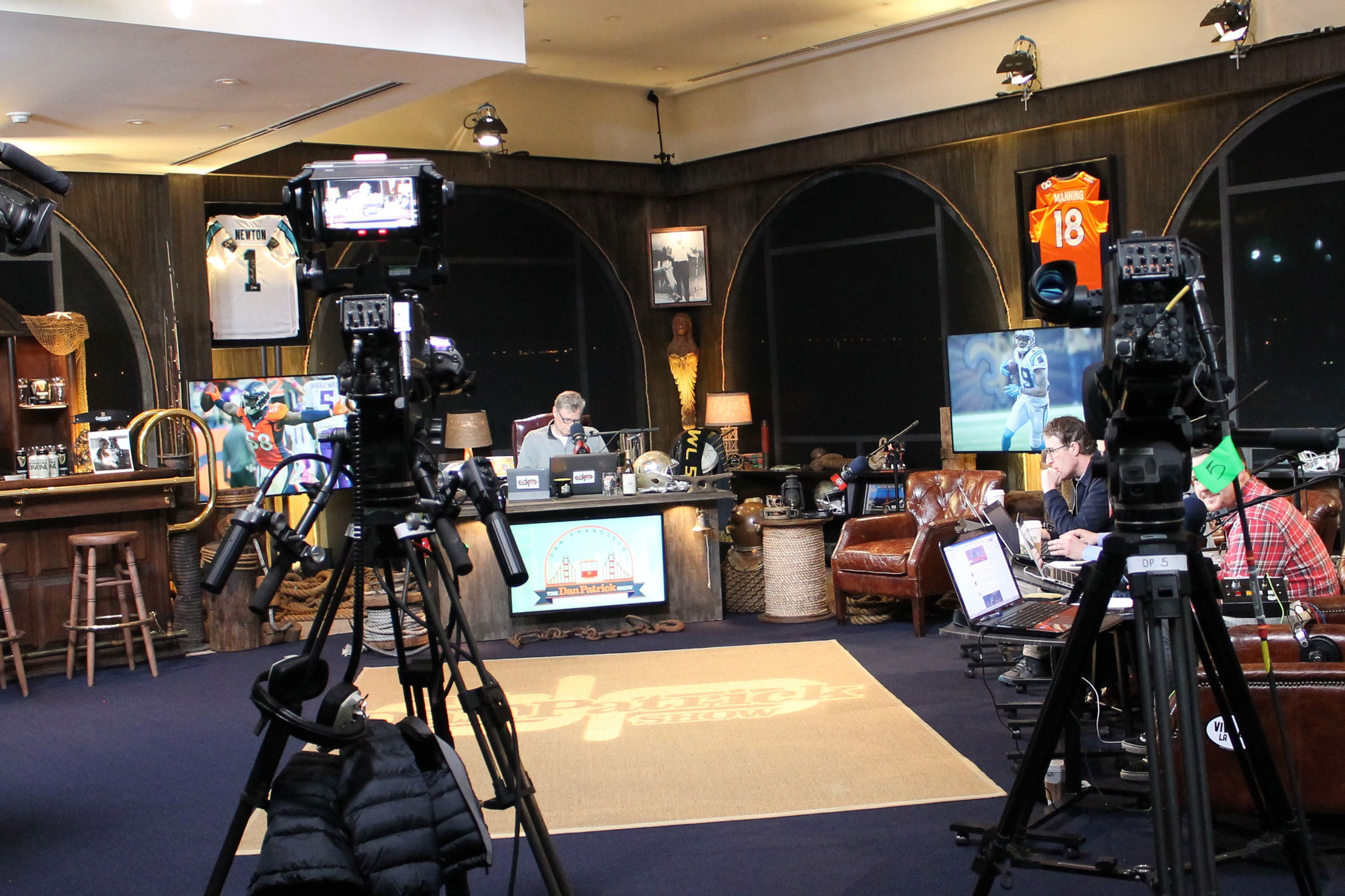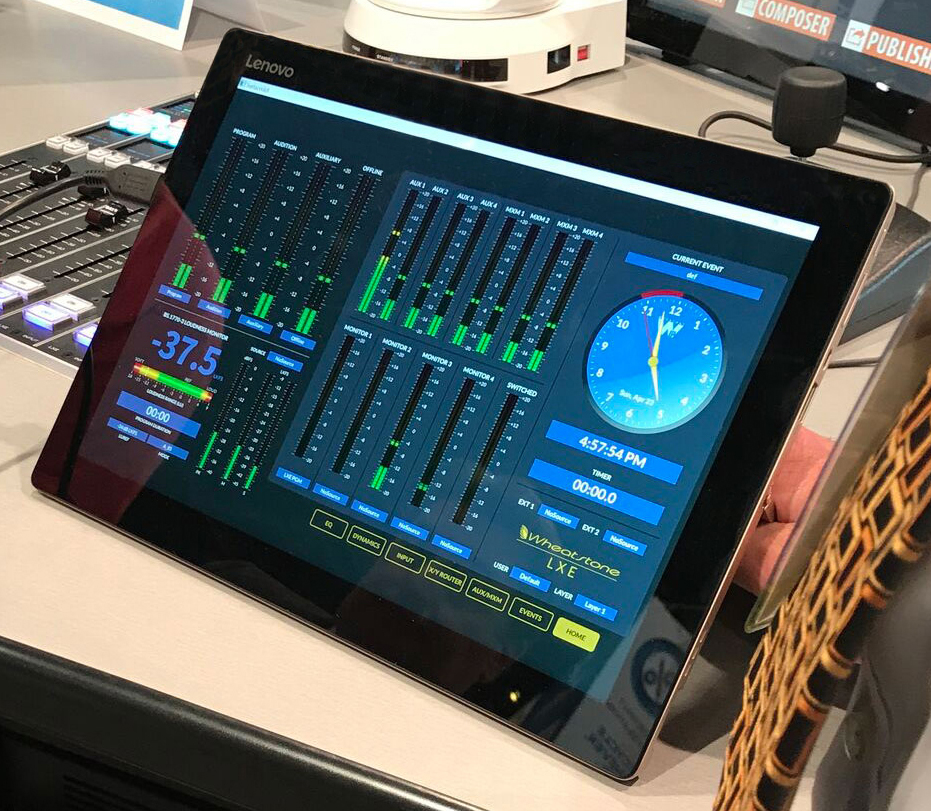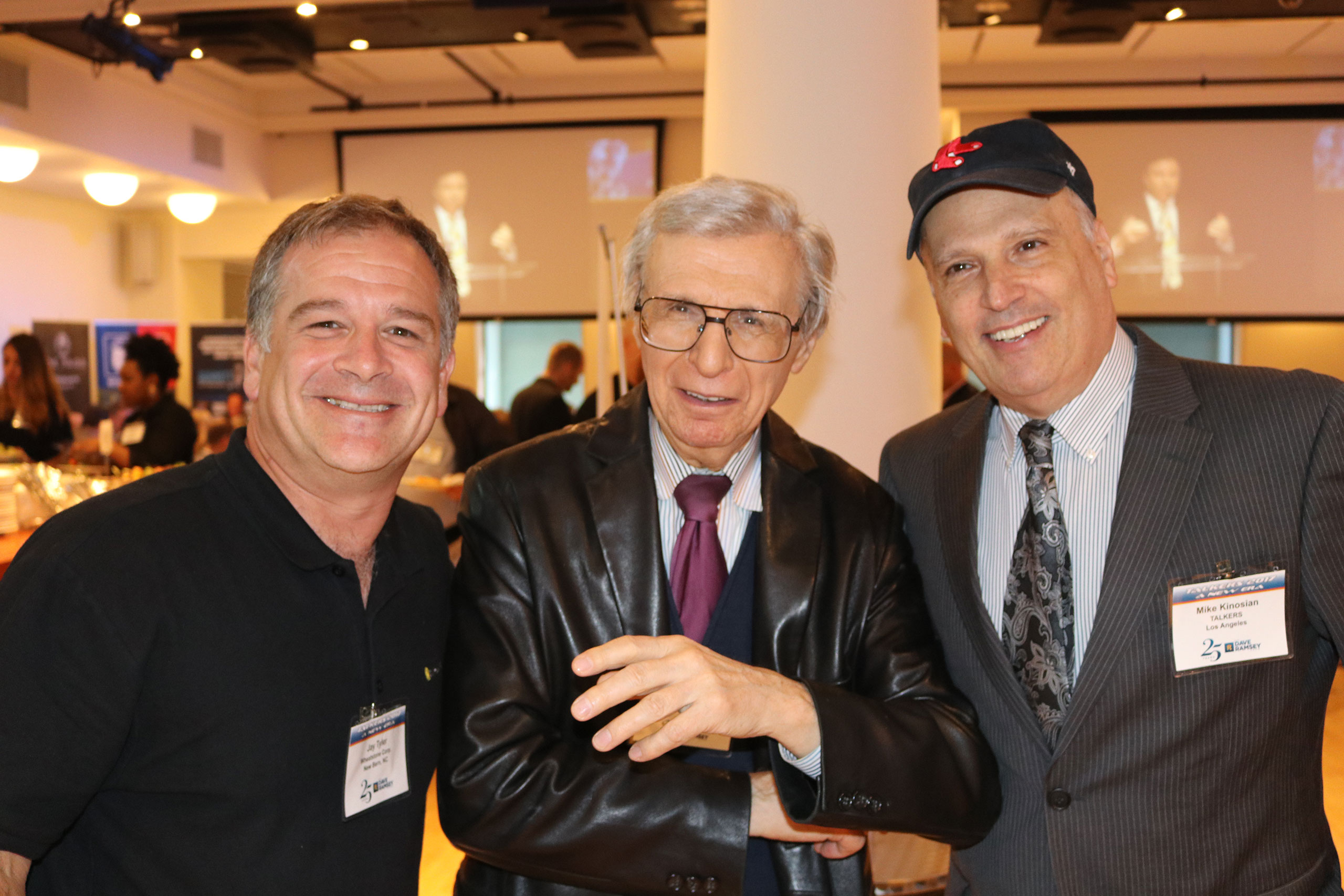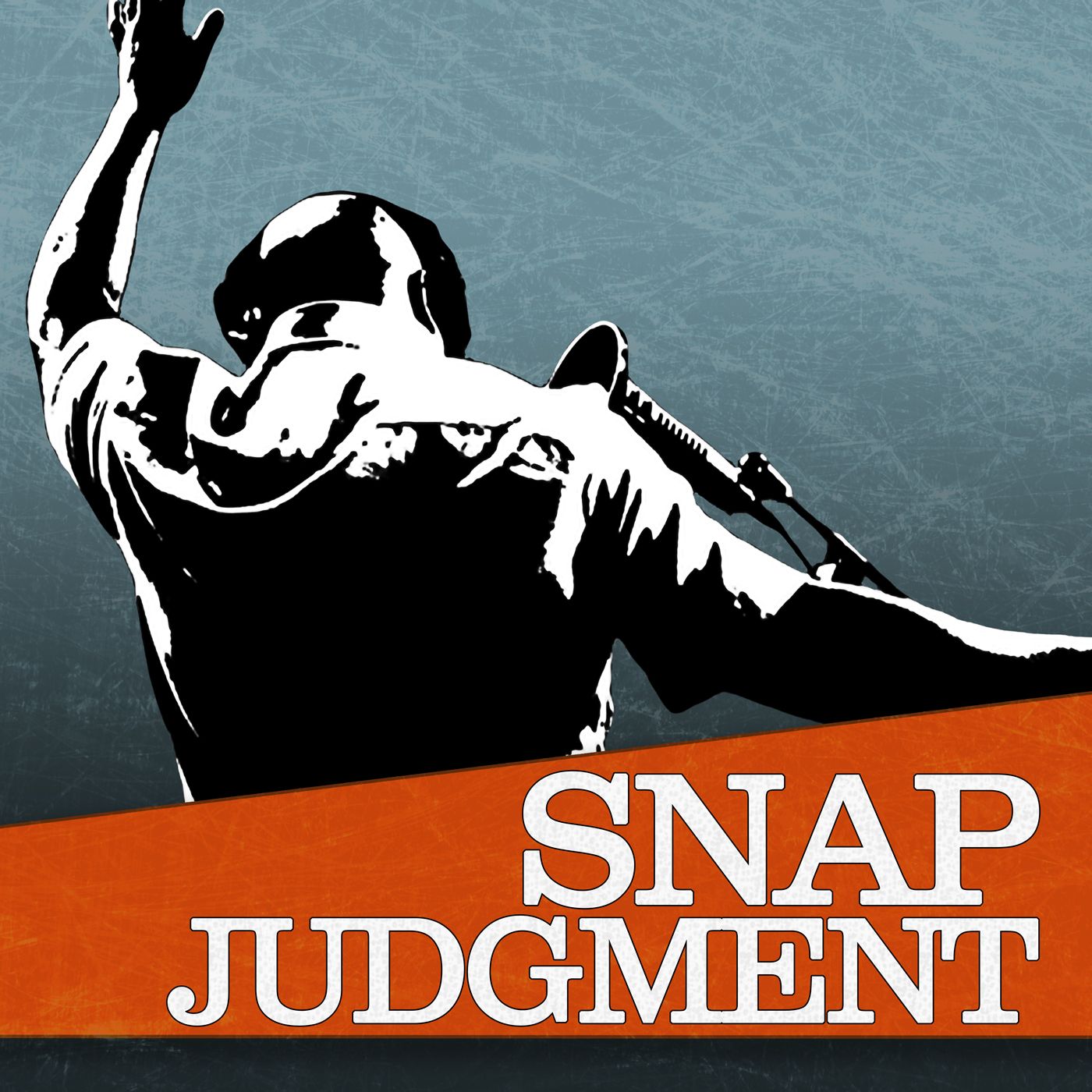WHEAT:NEWS RADIO
June 2017
Vol 8, No6
Got feedback or questions? Click my name below to send us an e-mail. You can also use the links at the top or bottom of the page to follow us on popular social networking sites and the tabs will take you to our most often visited pages.
Countdown To the Big Game
Live remotes are what keep broadcasters up at night. But after nine years of extravagant remotes the week before the NFL’s Big Game, Jim Hibbard of Pacific Mobile Recorders knows to expect the unexpected and is prepared like a Boy Scout! He’s the audio engineer responsible for The Dan Patrick Show NFL remote every year. Any pops, clicks, or dropouts of any kind can be heard by some 1.2 million weekly sports fans tuning into The Dan Patrick Show during the week preceding the Big Game.
In just a few months, Jim Hibbard will be packing several hundred pounds of audio necessities onto pallets and heading out to the remote site for some pre-game fun with all the guests that arrive that week in anticipation of the Big Game itself.
It’s never too early to start planning.
Jim will no doubt be dealing with all the usual issues: arranging IFB between producer/talent/director in three geographic locations, getting phone calls and bumper music from the show’s studio in Connecticut to the talent at the remote site, and handing off audio to the show’s syndicator, Premiere Radio Networks, as well as to its television producer, the DirecTV Audience Network. The show is also seen on the NBC Sports Network.
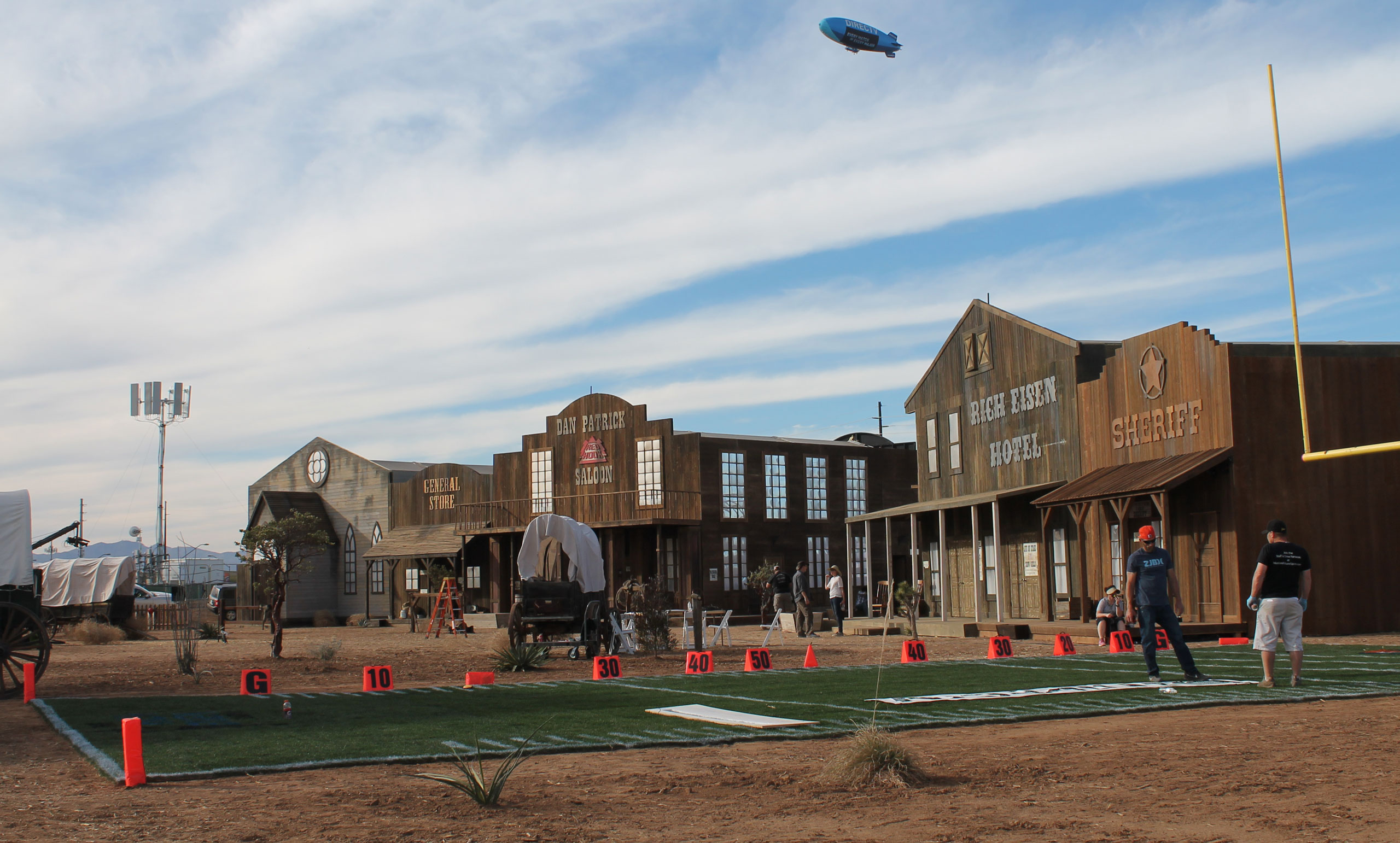 The week will likely hold a few surprises as well, starting with the many guests. The weeklong remote for The Dan Patrick Show includes any number and variety of high-profile guests, from actors Adam Sandler, Ryan Reynolds, Kevin Bacon and Jerry Seinfeld, to athletes Joe Montana, Dan Marino, Steph Curry and Emmitt Smith, plus coaches, sports commentators, and the NFL superstars themselves.
The week will likely hold a few surprises as well, starting with the many guests. The weeklong remote for The Dan Patrick Show includes any number and variety of high-profile guests, from actors Adam Sandler, Ryan Reynolds, Kevin Bacon and Jerry Seinfeld, to athletes Joe Montana, Dan Marino, Steph Curry and Emmitt Smith, plus coaches, sports commentators, and the NFL superstars themselves.
One thing’s for sure: all the audio will be running through the WheatNet-IP audio network, as it has for the past nine years.
WheatNet-IP audio runs over a fiber link using Tieline Genie and Merlin codec units, joining together operations and directors, producers, talent and content for the syndicated radio show as well as television production in separate locations.
The studios are geographically dispersed. Typically, the multi-camera shoot is switched in Los Angeles, which is some 3,000 miles from the home studio in Milford, Connecticut. But, for the remote, cameras are switched in nearby production trucks that are rolled in for the occasion, and the video feed then is uplinked to Los Angeles and on to the rest of the world. Meanwhile, the main studio for the radio show is in Milford, with IP audio shuttled between the remote site and the Milford studio.
At the remote venue, the show is broadcast from a large set which serves as a ‘make-shift studio’ complete with several WheatNet-IP TS-4 remote turrets and M4IP mic pre-amps and a fiber link to the backstage control area at the center of which is an IP-networked 12 channel control surface, the Wheatstone E-1.
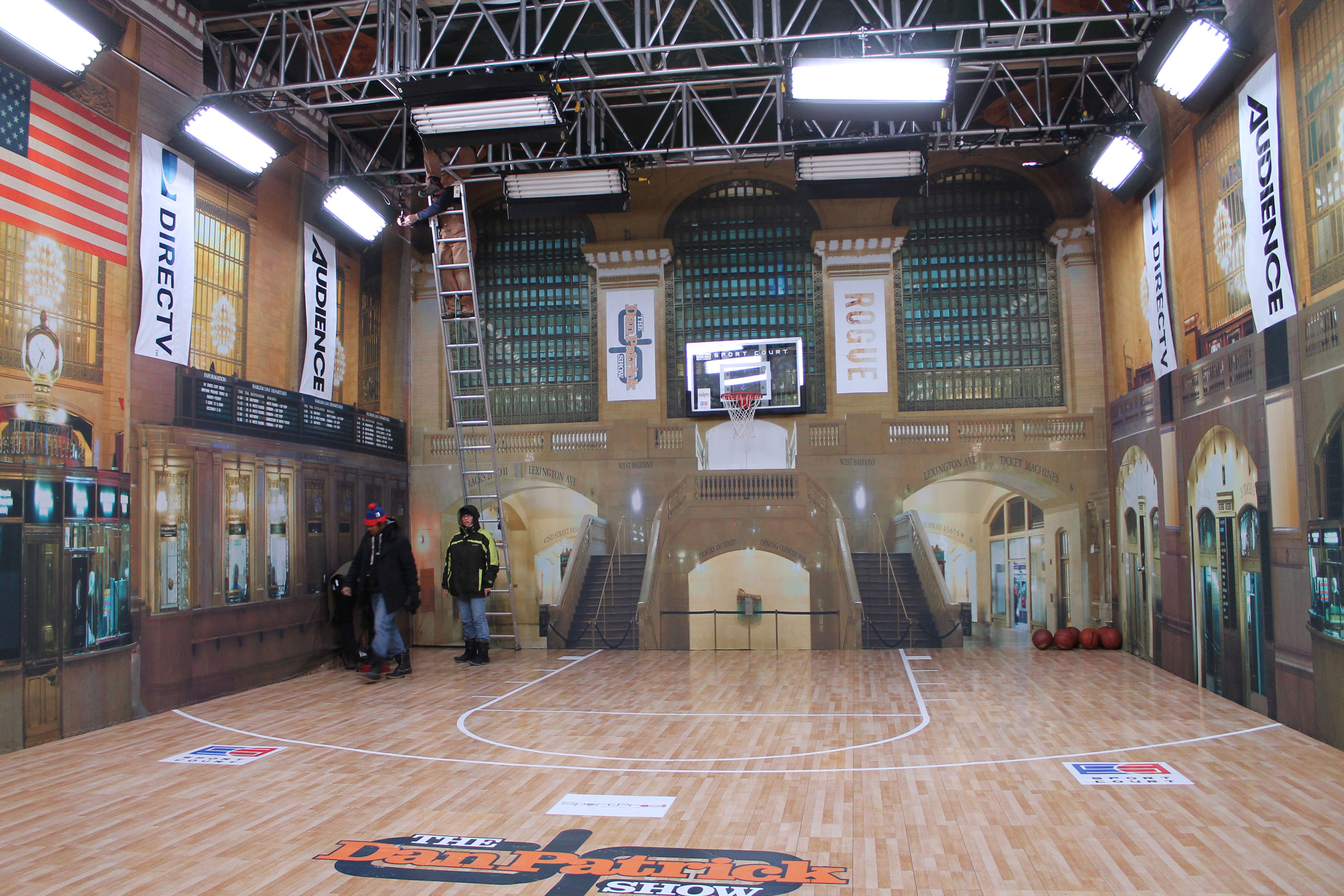 The studio setup for the 2018 game in Minneapolis remains to be seen. Each event provides unique challenges in terms of space and acoustics. One year, the remote was set in three large temporary buildings on an acre of land complete with a waterfall! Another year, the two-story set was built on the top of the parking lot at Pier 40 in lower Manhattan. That one included a half-size regulation basketball court on the second floor!
The studio setup for the 2018 game in Minneapolis remains to be seen. Each event provides unique challenges in terms of space and acoustics. One year, the remote was set in three large temporary buildings on an acre of land complete with a waterfall! Another year, the two-story set was built on the top of the parking lot at Pier 40 in lower Manhattan. That one included a half-size regulation basketball court on the second floor!
Hibbard also manages the remote audio for the Rich Eisen Radio Show during the week leading up to the Big Game.
Jim has his work cut out for him. But at least audio over IP across all studios and locations takes a few worries off his list. With all audio drops and phone calls being fed by the home studio, there’s no need to set up a separate number or additional phone lines at the remote site or to add equipment for audio drops since all feeds come through the IP connection between the remote site and the Milford studio. IP audio networking via WheatNet-IP also serves as an intercom backbone for talkback IFB.
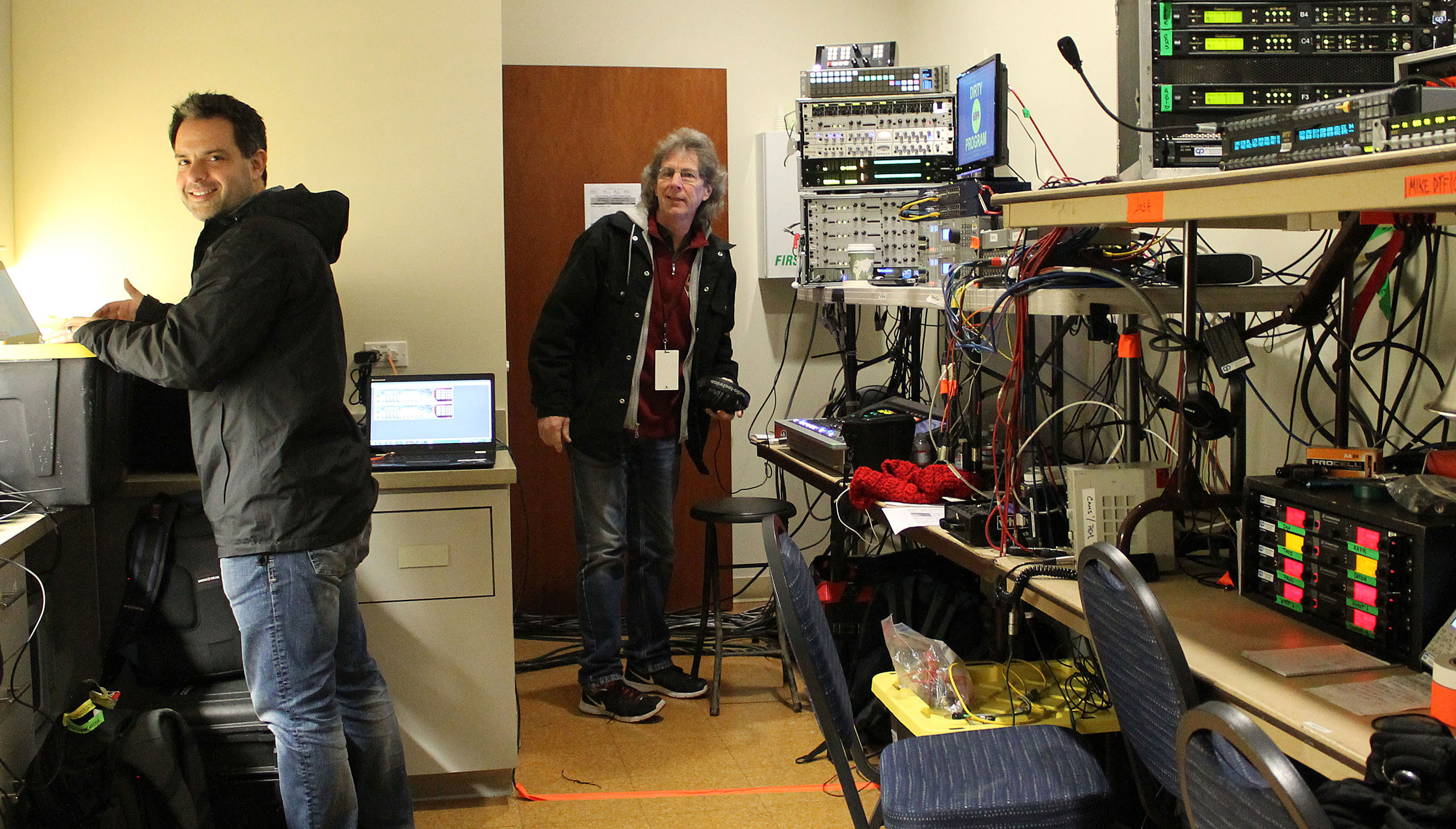 And those guests that pop in from time to time? Hibbard uses M4IP four channel mic processors for guests as well as Dan and the Danettes! The M4IP has all the dynamics processing to smooth out any voice, but also has an Ethernet port so all controls for those mics – including turning them on/off – run across the network and can therefore be done from the TS-4 talent stations and remote console.
And those guests that pop in from time to time? Hibbard uses M4IP four channel mic processors for guests as well as Dan and the Danettes! The M4IP has all the dynamics processing to smooth out any voice, but also has an Ethernet port so all controls for those mics – including turning them on/off – run across the network and can therefore be done from the TS-4 talent stations and remote console.
Hibbard says: “Using a Wheatstone console with audio over IP system gives us the flexibility and routing functions to easily provide everyone involved in the show the same comforts and quality of the home studio!”
The Dan Patrick Show is produced by DirecTV Audience Networks for television viewing and syndicated on more than 250 affiliate stations by Premiere Radio Networks.
Versatile or Virtual? You Decide.
When Beasley Broadcast set up a remote studio built out of cargo containers at Las Vegas’ Container Park two years ago, announcers initially broadcast from the location using a touchscreen interface that was essentially a bank of faders, knobs and other software widgets on a flat screen monitor mounted onto the furniture.
Virtual consoles like this eventually entered mainstream broadcast, thanks to software such as our ScreenBuilder app that makes it possible to create GUIs with the drag and drop of a widget on a screen, which can then be scripted for controlling devices and various elements in the IP audio network.
Then, something unexpected happened.
The lines between hardware and software started to blur. “It turns out that what we’ve learned about software apps is directly transferable to hardware,” says Kelly Parker, Wheatstone field engineer who oversaw the design of a new configurable console based on his years in the field designing and installing new studios.
By making surface controls completely programmable – and continually re-programmable – through a GUI similar to ScreenBuilder, we can say goodbye to fixed hardware. Instead of mapping switches, buttons and knobs to a particular function on the console that can never be changed, any button anywhere on our new LXE console can be programmed at any time for talkback, cue, start/stop or for toggling between functions, which can also be tied to different elements such as microphones.
We owe much of this adaptability to the maturation of IT and the evolution of Linux in particular. “We’ve gone to Linux kernels that are easy to manipulate, and a lot of them are open source so we can run them on different kinds of back ends, and that opens the game up to do all kinds of things,” comments Parker.
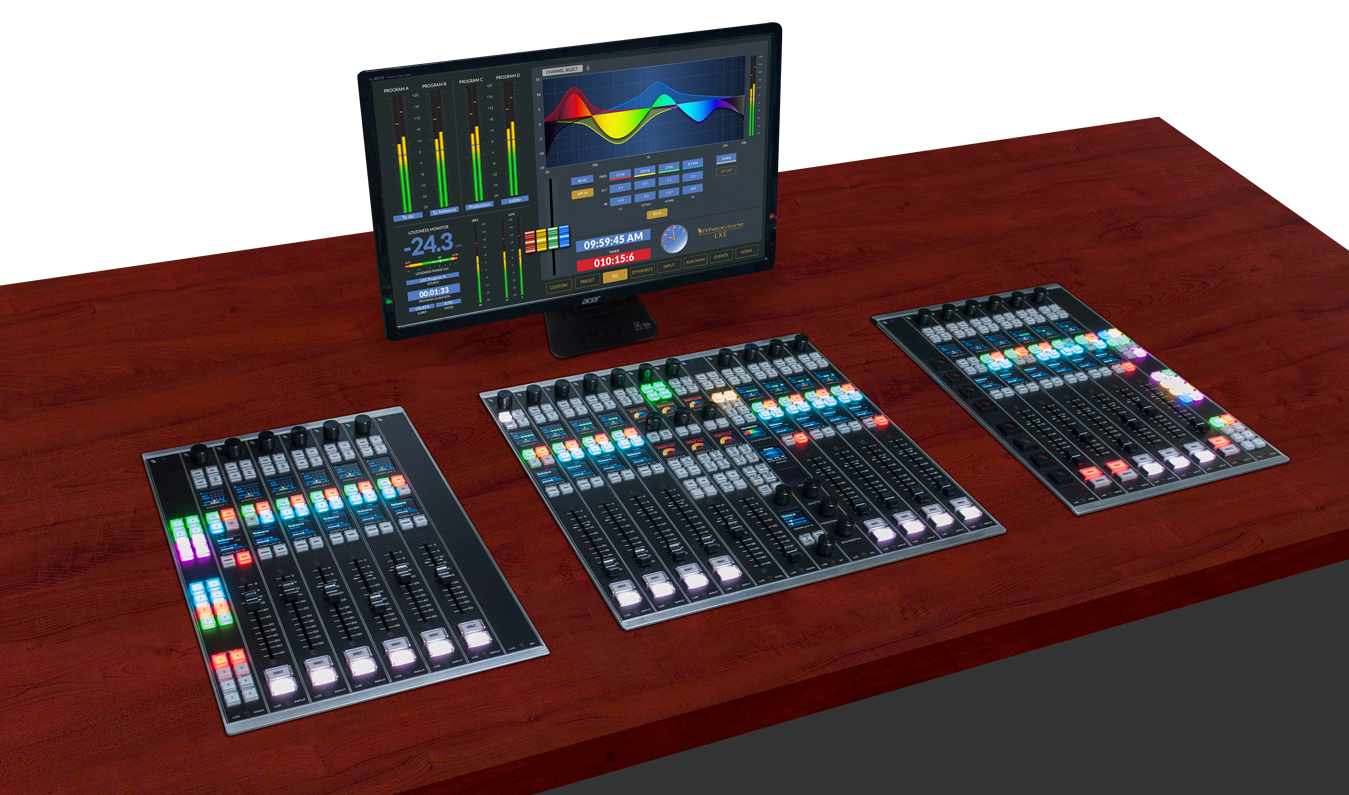 Among the many new capabilities resulting from this flexible architecture is a more dynamic split-console configuration, whereby two or more board ops can work off of separate LXE fader banks in the same room, or separate rooms networked together, in order to share mutes, tallies, speakers and other resources. Until now, there were limitations to splitting up fader banks. “IP audio consoles were traditionally bound to one mix engine for every surface and that really limited how they could be used,” explains Parker. Close collaborations of this nature often required a complete console reboot, making real-time sharing of resources and mixes impractical for most studio projects.
Among the many new capabilities resulting from this flexible architecture is a more dynamic split-console configuration, whereby two or more board ops can work off of separate LXE fader banks in the same room, or separate rooms networked together, in order to share mutes, tallies, speakers and other resources. Until now, there were limitations to splitting up fader banks. “IP audio consoles were traditionally bound to one mix engine for every surface and that really limited how they could be used,” explains Parker. Close collaborations of this nature often required a complete console reboot, making real-time sharing of resources and mixes impractical for most studio projects.
With this new flexible architecture, we now have the ability to network multiple surfaces through a shared I/O engine or network a surface to multiple engines. With multiple consoles accessing a common I/O point, talent can share sources and feeds in realtime, plus open and close mics, apply signal processing, handle IFB backlinks and essentially work closely together from separate LXE fader banks located anywhere inside, or outside, the studio. They can even co-produce from an auxiliary LXE Windows or Apple tablet in real-time while another board op is actively producing on the main LXE surface!
We’re just now discovering what it means to blur the line between software and hardware.
Meet the Talkers
Jay Tyler, left, with legendary talker The Amazing Kreskin and Mike Kinosian, Talkers West Coast Bureau Chief, during the Talkers 2017 Summit in New York, where talk media’s longest running convention was held last month. Wheatstone showed its new VoxPro digital audio recorder/editor with nondestructive editing while recording, a feature of particular interest to sportscasters and others requiring real-time editing during games or news coverage. With this new feature, hosts and announcers are able to quickly put together short game highlights and other promos without interrupting a recording of the game play-by-play at the same time. Also of interest to talkers at the summit: VoxPro’s Gap Buster feature that automatically removes silence from interviews and phone calls.
Uptime All The Time
There used to be a perception that IP wasn’t reliable. In the early years, that may have been the case, but IP audio has proven to be quite reliable, especially since there are redundancies built into systems like WheatNet-IP.
In fact, one I/O BLADE in particular that’s been operating at a station for years now has logged 1,053 (as of May 23) days continuous uptime – not including the 1,400-plus days already elapsed before the BLADE was rebooted for a UPS battery change.
All total, this BLADE, which happens to be serial number 001 running at Cox Media Group in Tampa, Florida, has logged 2,453 days of continuous uptime with the exception of one re-boot due to routine maintenance.
We’ve Got Vinyl Spinning
This Audioarts Air-4 console doesn’t always play vinyl, but when it does, we hear it sounds pretty good! KBYS-FM has been using Air-4s in the production and on-air studio since it went on the air in May of 2014, and recently purchased an IP-16 digital audio console with WheatNet-IP audio networking and M4IP-USB four channel mic processor for a new student studio for one of its HD channels.
Video courtesy of David Wynn, Operations Manager at McNeese State University, KBYS-FM, Lake Charles, LA.
Your IP Question Answered
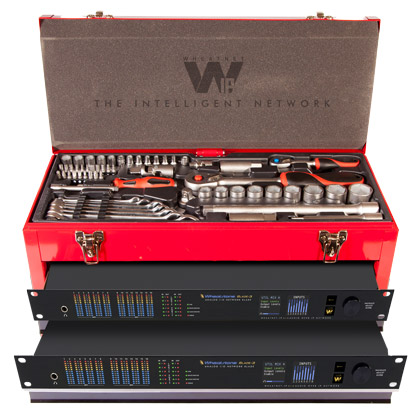
Q: I understand that Wheatstone now carries the PR&E line and makes a PR&E console with audio over IP routing. What’s different about this console line and your other IP consoles?
A: The DMX audio IP console line is designed for the two- or three-studio facility where each studio can act independently as a separate standalone entity, but the studios are linked together through an IP network. The DMX console surface is available with a 1RU DMX mix engine and 1RU Razor I/O module, which are similar to the BLADEs you might be familiar with in the WheatNet-IP audio networking environment but are more streamlined as an easy studio add-on. The DMX line includes all the network basics (there’s no need for an external Ethernet switch, for example) yet integrates easily into most existing radio automaton systems using proven WheatNet-IP automation drivers.
Distortion, Phase Linearity, New Gear, and Power. Steve Dove Tells All.
At an NAB 2017 technical presentation, Wheatstone's Minister of Algorithms, Steve Dove, delivered a fascinating lecture about the value of distortion in various audio processing applications. Scott Fybush caught up with him and Steve gave a summary of what he talked about. Whatever you think, we believe you’ll be surprised…Lots of other fun topics, too!

Wheatstone
-
WDWS-AM (Champaign, IL) purchased three LX-24 and two L-8 control surfaces through RF Specialties of Missouri.
-
Nashville Public Radio’s WPLN-FM (Nashville, TN) purchased four additional BLADEs for an existing WheatNet-IP audio network.
-
WHQR-FM (Wilmington, NC) purchased four WheatNet-IP audio network BLADEs.
-
iHeartMedia (Boston, MA) purchased three I/O BLADEs to expand an existing WheatNet-IP audio network.
-
WUNC-FM, North Carolina Public Radio, (Chapel Hill, NC) purchased an E-6 control surface and Gibraltar router to expand an existing WheatNet-IP audio network.
-
National Basketball Association (Secaucus, NJ) purchased a virtual mixing system.
-
Charter / New York 1 News (New York, NY) purchased a MADI card for an existing Wheatstone router system.
-
Cox Media (Orlando, FL) purchased three LX-24 control surfaces and WheatNet-IP audio networking.
-
Cox Media (Jacksonville, FL) purchased three LXE control surfaces and 30 WheatNet-IP audio network BLADEs.
-
KePadre Radio (San Francisco, CA) purchased LX-24, L-8 and E-1 control surfaces and WheatNet-IP audio network BLADEs.
Audioarts Engineering
-
WDZU-FM (Green Bay, WI) purchased an Air-5 console.
-
KOAL-AM (Price, UT) purchased an Air-4 console.
-
KMXE-FM (Red Lodge, MT) purchased an Air-4 console.
Wheatstone Audio Processing
-
Radio One (Houston, TX) purchased four M1 mic processors.
-
WUOM-FM, University of Michigan, (Ann Arbor, MI) purchased an Aura8-IP multi-mode audio processor.
-
Entercom (Denver, CO) purchased two AirAura X3 spectral audio processors and four SG-192 stereo generators.
-
IHeartMedia (New York, NY) purchased an M4IP-USB four channel mic processor and an M1 mic processor.
-
Beasley Broadcast (Boston, MA) purchased an FM-55 audio processor.
-
Beasley Broadcast (Augusta, GA) purchased an FM-55 audio processor.
-
Texarkana Radio (Texarkana, TX) purchased two AirAura X1 audio processors.
VoxPro
-
Saga Communications (Bellingham, WA) purchased a VoxPro 6 digital audio recorder/editor.
-
Univision (Miami, FL) purchased two VoxPro 6 digital audio recorder/editors.
-
CBS (Atlanta, GA) purchased a VoxPro 6 digital audio recorder/editor.
-
WAWZ-FM (Trenton, NJ) purchased a VoxPro6 digital audio recorder/editor.

